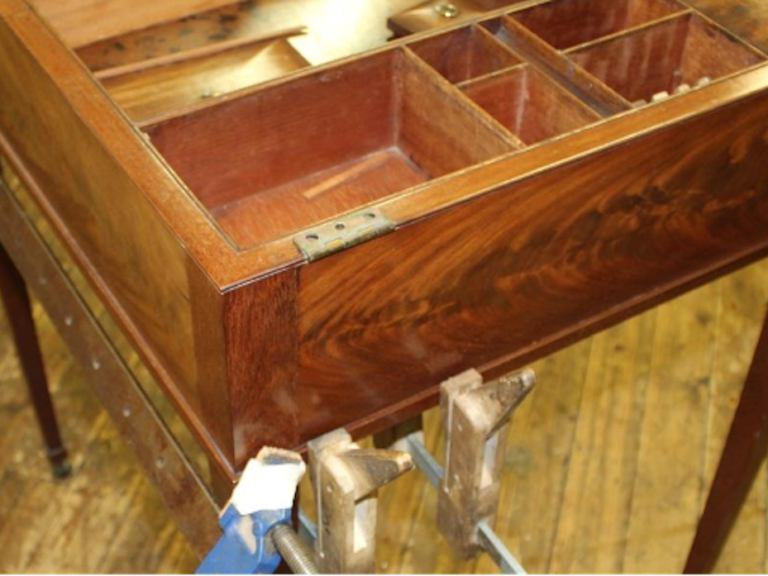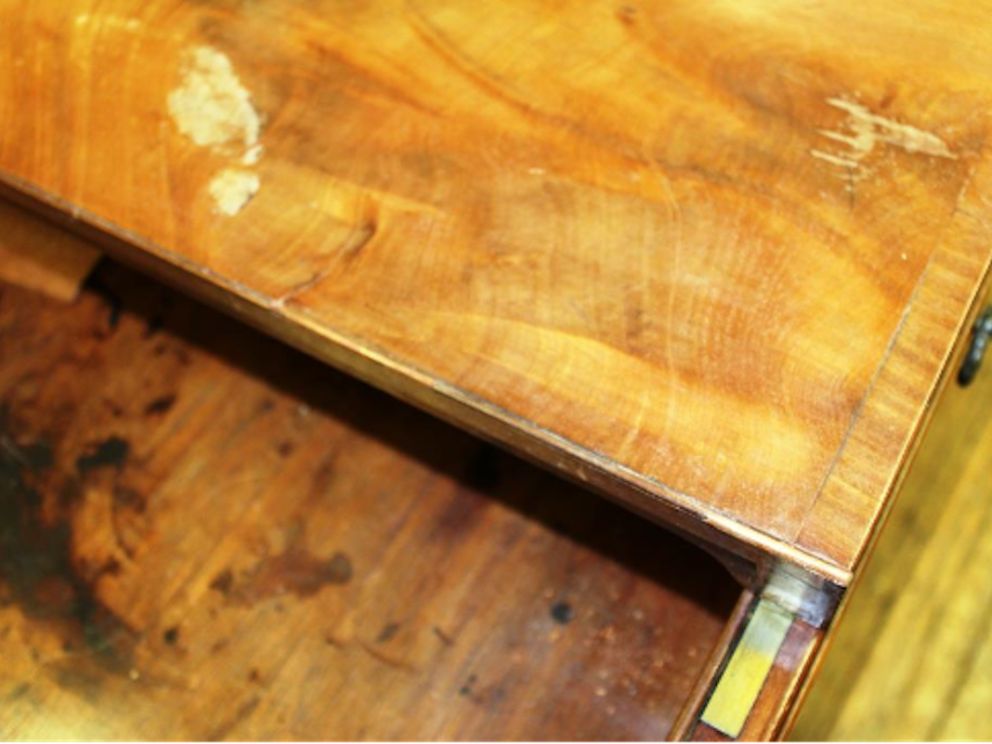
Conservation: Lady's Dressing Table
Thomas Chippendale the Younger (1749-1822), Lady’s Dressing Table, c.1780-1790
Mahogany, oak, pine, brass fittings
This exquisitely crafted dressing table was commissioned for Paxton House by the enslavers Ninian and Penelope Home and would have been used to store make-up, hairbrushes, other beauty items, and possibly jewellery. Penelope Home would have been dressed by her enslaved maid, Martine, who had travelled with the Homes from Grenada in 1788 and remained at Paxton for about 2 years. The last we know of Martine from the Home archives is that she was to return to Grenada, but no-one could be spared to accompany her to the ship.
Here curator Dr Fiona Salvesen Murrell takes us through the steps taken by accredited furniture conservator, Fergus Purdy, to conserve this stunning piece of furniture in his workshop in Northern Ireland. The ratcheted mirror was left in store at Paxton to reduce the risk of damage.

The Hinged Lid
The damaged and detached sections of the folding lid, viewed left side, were removed from the table and set on a workbench. The many small sections of veneer and other loose pieces that had been stored in the interior of the top were carefully sorted through to identify which belonged to the table and which were from other artefacts; these were then separated.
The damage to the left side section of the lid was then repaired in stages. Initially a small area of split and lifting veneer on the edge of the large central flame mahogany panel of the top of the lid and a veneer bubble on the same section were cleaned and laid back down using hot hide glue. This was undertaken first as the clamping for this repair was easier with the top panel still detached from the frame of the lid.

Side moulding
The main body of the table was carefully dusted with a hogshair brush and vacuum cleaner. The loose, partially detached length of flat rectangular section moulding along the viewed left side of the table was re-attached by cleaning the glue joint surfaces with hot water, then when dry, re-gluing the moulding in place using hot hide glue and clamping it in position until the glue joint had set.

The Fitted Interior
The detached original sections of the fitted interior were likewise identified and then re-secured in place using hot hide glue. The short length section of divider in front of the viewed right back lidded compartment, had a full width break in it repaired before it was re-fitted. It was noticed that the dividers with the crested top edge had their own framing members, this arrangement was reassembled, but the block left unfixed within the compartment.
A replacement was made and fitted for the missing short length section of the mahogany dividers, positioned behind the viewed right front lidded compartment. The replacement was colour matched using van dyke crystals and sealed with a single brush coat of shellac varnish. A replacement lid and supporting stilts were made for the front right compartment using good quality old mahogany fitted with a brass ring handle. The replacement lid was stained and polished to blend with surrounding old surfaces.
A set of four supporting stilts were fitted to the compartment below the small lidded box, so that the level of its lid was the same as the other lids in the table. A replacement corner support / stilt was also fitted to the large back lidded compartment on the viewed left side.

Finishing
The finished surfaces of the dressing table were dry buffed using 0000 grade wire wool and the areas of old water damage on the top surfaces of the viewed right side of the hinged top were treated with a small amount of white spirit. The surfaces were then wax polished with Harrell’s Furniture Wax using a soft cotton cloth until a good surface sheen had been achieved.
The table was returned to Paxton House, where the mirror frame was cleaned and wax polished, with an area of old water damage on the back board for the mirror toned-in using van dyke water stain. The surface of the mirror was cleaned with cotton wool pads moistened with de-ionised water. The mirror was then fitted back into the dressing table.
There are two Lady’s Dressing tables in the Paxton Trust’s Chippendale collection. One has been on display since the house opened to the public, but had not been conserved, and the other had been in storage because it was in such a fragile and damaged state. The most dramatic transformation has been to the dressing table that was in store, which is actually the most intact and original of the two surviving dressing tables. Both were conserved in late 2021, revealing more of the history of the women of Paxton, including the enslaved African maid, Martine.








